Plus Two Botany Notes Chapter 1 Reproduction in Organisms is part of Plus Two Botany Notes. Here we have given Plus Two Botany Notes Chapter 1 Reproduction in Organisms.
| Board | SCERT, Kerala |
| Text Book | NCERT Based |
| Class | Plus Two |
| Subject | Botany Notes |
| Chapter | Chapter 1 |
| Chapter Name | Reproduction in Organisms |
| Category | Plus Two Kerala |
Kerala Plus Two Botany Notes Chapter 1 Reproduction in Organisms
Asexual Reproduction
| The offspring shows similarity in morphological and genetical characters. They also shows resemblance to their parents i.e they are exact copies. So they are called as clone. |
Binary fission in Amoeba

| In Protists and Monerans, the parent cell divides into two and give rise to new individuals. In such a case cell division is the mode of reproduction. It is called binary fission (e.g., Amoeba, Paramecium). |
Budinq in yeast
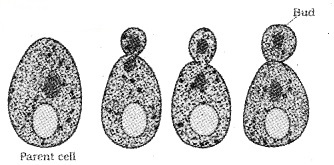
| In yeast, the division is unequal and small buds are produced that remain attached initially to the parent cell which, later separated and mature into new yeast organisms (cells). |
Formation of zoospore
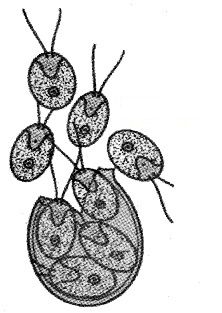
| Members of the Kingdom Fungi and simple plants such as algae reproduce through special asexual reproductive structures are called zoospores (motile structures). |

| Other common asexual reproductive structures are conidia (eg-Penicillium), buds (eg-Hydra) and gemmules (eg-sponge). |
In plants the asexual reproduction mainly by the units of vegetative propagative structures. They are
- Runner
- Rhizome
- Sucker
- Tuber
- offset
- bulb.
They are capable of giving rise to new offspring. These structures are called vegetative

In water bodies, aquatic plant ‘water hyacinth’ is an invasive weed, called as the ‘Terror of Bengal’. Because it can propagate and spread all over the water body in a short period of time. It depletes the amount of oxygen, which leads to death of fishes.
Another examples of vegetative propagation are the origin of new plants from the buds (called eyes) of the potato tuber, from the rhizomes of banana and ginger.
In some plants adventitious buds arise from the notches present at margins of leaves eg- Bryophyllum. So it is used for the commercial propagation of plants.
Sexual Reproduction
It involves formation of the male and female gametes of the same individual or different individuals of the opposite sex. These gametes fuse to form the zygote which develops to form the new organism.
So the offsprings are not identical to the parents or amongst themselves. They are different in external morphology, internal structure, and physiology.
The growth period of organisms before reproduction is called the juvenile phase (vegetative phase).This phase shows variable durations in different organisms.
It is found that some plants flower throughout the year and some others that show seasonal flowering. But few plants exhibit unusual flowering phenomenon;
| Bamboo It flowers only once in their life time, after 50 – 100 years, produce large number of fruits and die. Strobilanthus kunthiana (neelakuranji). It flowers once in 12 years. Recently this plant flowered hilly areas in Kerala, Karnataka, and Tamil Nadu into blue stretches during September-0ctober2006 and attracted a large number of tourists. |
In animals, the juvenile phase is followed by morphological and physiological changes. But the duration of reproductive phase is varying in different organisms.
Some animals lay their eggs throughout the year but others seasonally. The females of placental mammals exhibit cyclical changes in the ovaries as well as hormones during the reproductive phase.
| In non-primate mammals like cows, sheep, rats, deers, dogs, tiger, etc., such cyclical changes during reproduction are called oestrus cycle where as in primates (monkeys, apes, and humans) it is called menstrual cycle. |
Many mammals exhibit such cycles only during favourable seasons in their reproductive phase, they are called as seasonal breeders. The other mammals are reproductively active throughout their reproductive phase they are called continuous breeders.
The end of reproductive phase is called as senescence or old age. Later it leads to death. In both plants and animals, hormones and environmental factors regulate the reproductive processes and behavioural expressions of organisms.
Events in sexual reproduction: It involves
- pre-fertilisation
- fertilisation
- post-fertilisation
1. Pre-fertilisation Events:
These include gametogenesis and gamete transfer.
a. Gametogenesis:
It is the process of formation of two types of haploid gametes – male and female.
| In some algae the two gametes have similar morphology, they are called as homogametes or isogametes. |

| Some sexually reproducing organisms produce the gametes of two morphologically distinct types (antherozoid or sperms egg or ovum). They are called as heterogametes. |
Sexuality in organisms:
Both the male and female reproductive structures are present in the same plant, they are bisexual or on different plants, they are unisexual.
Homothallic and monoecious are used to denote the bisexual condition Eg-some fungi and plants. Heterothallic and dioecious are used to denote unisexual condition.
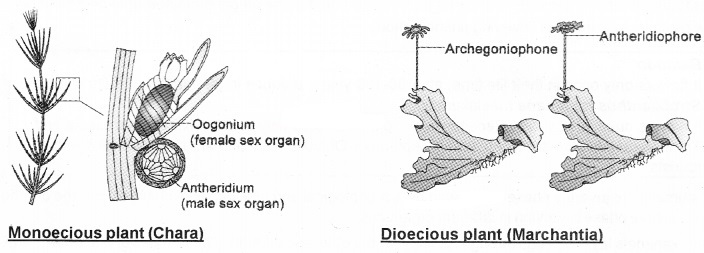
In flowering plants, the unisexual male flower is staminate, i.e., bearing stamens, while the unisexual female flower is pistillate i.e bearing pistils.
In some flowering plants, both male and female flowers are present on the same individual (monoecious) eg- cucurbits and coconuts or on separate individuals (dioecious) eg- papaya and date palm.
| Earthworms, sponge, tapeworm, and leech, etc. are bisexual animals that possess both male and female reproductive organs, they are called hermaphrodites. |
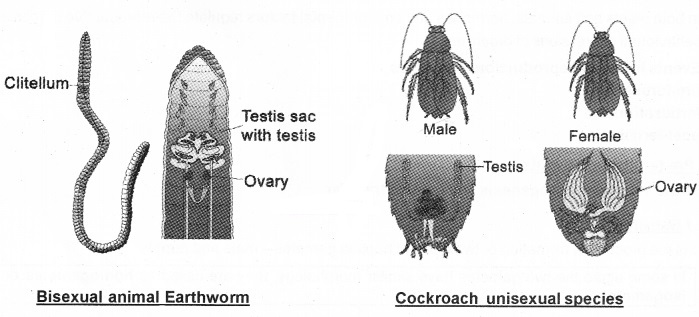
Cell division during gamete formation:
Diploid parent that produces haploid gametes by reduction division meiotic division. But the haploid parent produces gametes by mitoticdivision.
Members of monera, fungi, algae, and bryophytes have haploid plant body, but pteridophytes, gymnosperms, angiosperms, and human beings have diploid parent body.
| In diploid organisms, meiocytes undergo meiosis to form haploid gametes contain only one set of chromosomes. |
b. Gamete Transfer:
In most organisms, male gamete is motile and the female gamete is stationary. But few fungi and algae both types of gametes are motile.
They need water as a medium through which the male gametes moves. In algae, bryophytes and pteridophytes. water is the medium through which the gamete transfer takes place.
In seed plants, pollen grains are the carriers of male gametes, and ovule have the egg. In dioecious animals the gametes are formed in different individuals and the organism have special mechanism for gamete transfer.
In bisexual, self-fertilising plants, e.g. peas, transfer of pollen grains to the stigma takes place when it come in contact with the stigma. But in cross pollinating plants pollination agency helps the transfer. Pollen grains germinate on the stigma and the pollen tubes carrying the male gametes reach the ovule and discharge male gametes near the egg.
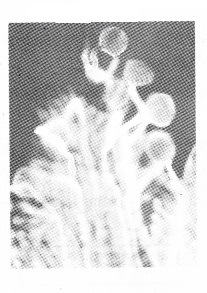
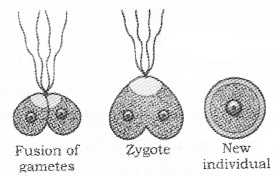
2. Fertilisation:
It is the fusion of gametes. This process is called syngamy leads to the formation of a diploid zygote.
| In rotifers, honeybees, some lizards and birds (turkey), the female gamete undergoes development to form new organisms without fertilisation. This phenomenon is called parthenogenesis. |
In most aquatic organisms, such as algae, fishes and amphibians syngamy occurs outside the body of an organism (water) This type of gametic fusion is called external fertilisation.
For this, male partner release a large number of gametes into the surrounding medium (water). This is the case of bony fishes and frogs where a large number of offspring are produced.
One disadvantage is that the offspring are here prey, subjected to the attack of the predators. In terrestrial fungi, reptiles birds, mammals, and plants (bryophytes, pteridophytes, gymnosperms, and angiosperms), syngamy occurs inside the body of the organism, it is called internal fertilisation.
Here the male gamete is motile and has to reach the egg for fertilisation. In seed plants, the non-motile male gametes are carried to female gamete by pollen tubes.
3. Post-fertilisation Events:
It involves events afterthe formation of zygote.
a. The Zygote:
In fungi and algae, zygote develops a thick wall that is resistant to descication and damage. It undergoes a period of rest before germination.
In organisms with haplontic life cycle, zygote divides by meiosis to form haploid spores that grow into haploid individuals.
| Zygote is the vital link that maintains the continuity of species between organisms of one generation and the next. |
b. Embrvoaenesis:
It is the process of development of embryo from the zygote. During embryogenesis, zygote undergoes cell division and cell differentiation (modifications to form specialised tissues and organs).
In oviparous animals like reptiles and birds, the fertilised eggs are covered by hard calcareous shell, it undergoes period of incubation and young ones hatch out.
On the other hand, in viviparous animals, the zygote develops into a young one inside the body of the female organism. Afterthe period of growth, they are delivered out.
In flowering plants, the zygote is formed inside the ovule. The sepals, petals and stamens of the flower wither and fall off.
| Zygote develops into the embryo. The ovules develop into the seed. The ovary develops into the fruit which develops a thick wall called pericarp (protective). |
Kinds of fruits showing seeds and pericarp
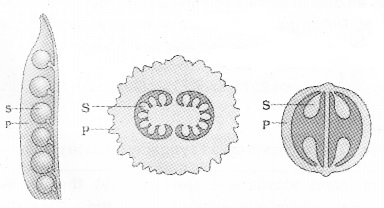
We hope the Plus Two Botany Notes Chapter 1 Reproduction in Organisms help you. If you have any query regarding Plus Two Botany Notes Chapter 1 Reproduction in Organisms, drop a comment below and we will get back to you at the earliest.
